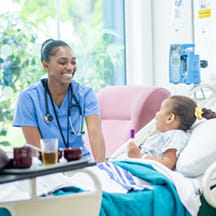Clinical surveillance is increasingly emerging as a high priority for children’s hospitals—nearly 90% of health care executives consider it important to their organization, according to a recent survey. While clinical surveillance has many potential uses—including identifying adverse drug events, advancing antimicrobial stewardship initiatives and managing patient safety alerts—a growing number of children’s hospitals are using the technology to prevent hospital-acquired infections.
“It's the greatest technology tool that has revolutionized our profession,” says Patsy Stinchfield, APRN, CNP, senior director of infection prevention at Children’s Minnesota in Minneapolis-St. Paul.
Clinical surveillance found everywhere and rapidly evolving
The concept of clinical surveillance—applying analytics to real-time patient and historical data to help provide a quantitative and qualitative assessment of a patient’s condition—has been around for a while.
In the same 2019 survey, 96% of hospital executives reported using some sort of clinical surveillance solution, and Stinchfield says Children’s Minnesota was an early adopter of the technology, implementing it nearly 15 years ago.
But the technology is rapidly evolving in its applications to prevent hospital-acquired infections, according to Stinchfield. She says previous systems collected all the pertinent patient data but still required human intervention to comb through paper microbiology reports and tie together separate incidents to identify a potential outbreak.
“Now the computer does it for us,” Stinchfield says. “It brings in more data from the electronic medical record and alerts you that you've got a pattern of potential infections developing. From my point of view, that would be one of the biggest technology advances in our field.”
The more proactive technology not only speeds up the identification of potential problems but frees up medical staff to address them. “It allows us to do what we're supposed to be doing—getting out there working with the nursing staff and physicians on prevention measures, cleaning and all of the bundles that we do for infection prevention.”
Peace of mind for patients and families
Stinchfield sees an added benefit of the clinical surveillance technology in easing potential concerns for patients and their families.
“Sometimes in children's hospitals, you'll get a parent who says, ‘My kid got sick from the hospital. Did they get this from being in that room?’” says Stinchfield. “Of course, we can easily say, ‘No, you didn't get it because we have tremendous cleaning protocols here,’ but we can actually support our answer with some data. We can look back at all the other patients who were in that room prior to them and look at what infections they had. Parents appreciate that we can actually look up the data and support our response.”


